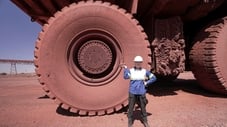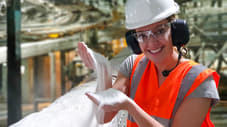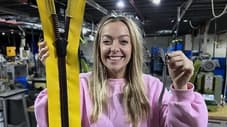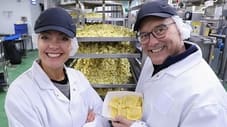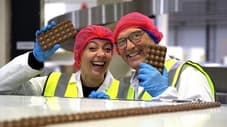
Inside the Factory (2015)
← Back to main
Michael Rees — Producer
Episodes 22
Cherry Bakewells
How a factory in Stoke-on-Trent produces 250,000 little cherry bakewell tarts every day - from what makes a shortcrust pastry 'short' to the team of 12 precisely placing the cherry on top of every one by hand. How to swerve a soggy pastry bottom when baking pies and tarts at home. How almonds are roasted and milled into almond butter ready for toast. The origin story of frangipane, the fragrant almond filling used in cherry bakewell. How the modern cherry bakewell actually descends from a mistake.
Read MoreWax Jackets
How a factory in South Shields produces 650 water-resistant waxed jackets a day - from 500-metre-long rolls of undyed cotton, to dipping the finished fabric into baths of heated wax, to assembling each jacket from 23 pieces. How a breathable membrane is key to allowing sweat to get out while keeping water from getting in. How a simple wooden stick is transformed into a top-notch umbrella using saws, pliers, and needle and thread - techniques barely changed in 150 years. The history of seamen adapting oil-covered sail cloth into garments.
Read MoreCroissants
How a factory in France produces 336,000 croissants every day - from the 21 tonnes of butter, to the 83-year-old strain of yeast that packs a flavourful punch, to the layering of very thin slices of butter between sheets of dough to create the famously flaky texture. How croissants are best served - and eaten. How 'concentrated' butter produced in north Wales enhances the shelf life of croissants. The history of the croissant, thought to originate from 17th-century Austria, and emerging in its modern French form as late as 1906. How bread played a vital role in the French Revolution.
Read MoreMattresses
How a factory in Leeds produces 600 bouncy beds every day - from making steel into springs, to their placement in individual pockets and covering in natural fibres like hemp and wool designed to wick away sweat. How a short, twenty-minute sleep improves reaction times. How wool is shorn from sheep, and its inherent anti-bacterial and fire-retardant properties that make it well suited to mattresses. How the modern spring mattress evolved. How a famous Scandinavian-inspired home store is responsible for popularizing the duvet.
Read MorePasties
How a bakery in Cornwall produces 180,000 Cornish pasties a day. There are rules: A Cornish pasty must be made in Cornwall; the filling can only contain onion, potato, swede, beef and some seasoning; and each ingredient must be cooked from raw within the pastry parcel. The versatility of onions, and how they make us cry. How anaerobic digestion turns food factory waste into electricity. Challenging the pasty's origin story. How importation of pepper eventually transformed it from a precious commodity to a spice that everyone could afford.
Read MorePots and Pans
How a foundry in France produces a cast iron pot every five seconds - from the arrival of 20 tonnes of crude iron right through to brightly coloured orange casserole dishes. How a South African iron ore mine - one of the largest in the world - produces a staggering 670,000 tonnes every day. The science behind cooking the perfect casserole - more cooking time isn't always better. The history of one-pot cooking to prepare simple meals, from communal ovens to 1970s slow cookers. How casting iron in sand moulds democratised the kitchen through affordable cookware.
Read MoreSoup
How a factory in Wigan produces two million tins of soup a day. Vegetable soup is followed from a pea harvest in Yorkshire right through to the finished soup going into cans and being dispatched. How the vitamin content of frozen vegetables can greatly exceed that of fresh. How a spinach soup based on a 17th-century recipe doesn't much resemble soup as we know it today. The history of the soup kitchen.
Read MoreLiqueurs
How a factory in Ireland produces 540,000 bottles of liqueurs a day. From grain, to barrel aging, to mixing cream and whiskey together, the show traces the production of a cream liqueur over the span of three years. How Ireland’s bottles and jars are recycled at a plant processing 500 tonnes every day. How all alcoholic drinks - not just aperitifs - stimulate appetite. The rules for producing and labelling whiskey, bourbon, and blends. How monks invented liqueurs. The impact of modern distillation methods on traditionally made alcohols like Irish whiskey.
Read MoreCereal Bars
How a factory in Essex produces 400,000 cereal bars a day - from nuts to cranberries and sultanas to puffed rice, with a carefully balanced blend of honey and glucose binding it all together for the ideal texture. How macadamia nuts are harvested in South Africa, and shelled under extraordinary pressure. The scientific distinction between botanical nuts, legumes and drupes. The history of Britain's cereal bars, including one Kendal Mint Cake snack bar made popular by famous explorers Ernest Shackleton and Sir Edmund Hillary.
Read MoreDiggers
How JCB make as many as a hundred iconic yellow diggers every single day in Rocester, Staffordshire, requiring just 45 hours to make a digger from scratch, and consuming 650 tonnes of steel, 170,000 bolts, 5,000 litres of paint and 236 miles of wiring each week.
Read MoreTrains
How Alstom builds a 187-tonne, five-carriage electric train on their 84-acre site in Derby. How the train's aluminium is made at the UK's last remaining smelter in Scotland. How tunnel boring machines are digging ten miles through the hills for the new HS2 line. The history of the UK’s first electric train - Brighton's seafront tourist train, still used today - and how that technology went on to be used in underground transportation all over the world.
Read MoreBuses
How London's famous red double-decker bus - including a fully electric model - is built in Scarborough, Yorkshire, highlighting the tough laminated heated windscreens and bright red coat of paint. How the turbines at an offshore wind farm convert wind into watts. The history of London's earliest double-deckers and their vital role in the First World War.
Read MoreYorkshire Puddings
How Aunt Bessie's produce a staggering 500 million Yorkshire puddings every year in Hull. How wheat is tested before it can be milled into flour. How to cook the perfect gravy for a Sunday roast. The history of the roast dinner, and the art of washing up Tudor-style.
Read MoreJelly Beans
How Jelly Bean Factory make ten million of their colourful little sweets every day in Dublin. The important role glucose plays in our bodies. How one of the ingredients in jelly beans plays a key role in the production of lipstick. The history of jelly and post-war pick'n'mix.
Read MoreJeans
How denim cloth is made, and how Welsh jeans brand Hiut transform it into one of the world's most popular items of clothing - jeans. How zippers are made. How denim is distressed to make a new pair of jeans look old, in environmentally friendly ways. The little-known person who helped shape the design of jeans forever. The history of indigo dye.
Read MoreStuffed Pasta
How Dell Ugo make 500 million stuffed pasta parcels every year in Hertfordshire. How Cromer on the Norfolk coast still use traditional fishing techniques to catch the crab for stuffed pasta. How Italian immigrants in Bedford helped to build Britain. The origins of gluten-free food.
Read MoreStout
How Guinness make two million litres of Irish stout every single day. How reservoir water is treated to provide clean drinking water to the people of Dublin, as well as to the stout brewery. How hops are harvested at a farm in Worcestershire. The history of Irish pubs, and how pub games helped the Allies in the Second World War.
Read MoreBath Bombs
How Lush produce an astonishing 14 million bath bombs every year in Dorset. How taking a hot bath can provide some of the benefits of exercise. How a lab grows human skin for cosmetic testing. The notion that complex perfumes ward off the plague. How the living conditions of coal miners and their families were transformed by the introduction of communal showers.
Read MoreCarpets
How Axminster produces 46,000 square metres of carpet every year in Devon. The science behind the best ways to remove stubborn stains from carpets such as butter, milk and red wine. How the groundbreaking methods of a Devon-based carpet maker in the 18th century revolutionised intricate carpet making. The rise and fall of the hard-wearing flooring linoleum.
Read MoreChocolate Bars
How Nestle make more than eight million bars of chocolate every day in York - the UK's city of chocolate. How a cocoa plant quarantine facility in the Berkshire countryside is preventing a worldwide chocolate shortage. The bitter history of drinking chocolate.
Read MoreSofas
How HSL make more than 5,000 sofas every year in West Yorkshire. The science of light bulbs, to create the perfect environment to snuggle up on the sofa. How foam padding is produced. The history of the sofa. One of the world's most famous sewing machines.
Read MorePaint and Wallpaper
How Farrow & Ball produce up to 200,000 litres of paint and 10,000 metres of wallpaper a week in Dorset. How a key ingredient in paint-making is mined in Devon. The art of hanging wallpaper, and its history. How ships in the First World War were painted with dazzling patterns to evade German submarines.
Read More




